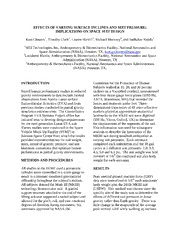
Effects of Varying Surface Inclines and Suit Pressure: Implications on Space Suit Design PDF
Preview Effects of Varying Surface Inclines and Suit Pressure: Implications on Space Suit Design
EFFECTS OF VARYING SURFACE INCLINES AND SUIT PRESSURE; IMPLICATIONS ON SPACE SUIT DESIGN Kurt Clowers1, Timothy Clark1, Lauren Harvill2, Richard Morency3, and Sudhakar Rajulu3 1MEI Technologies, Inc, Anthropometry & Biomechanics Facility, National Aeronautics and Space Administration (NASA), Houston, TX, [email protected] 2Lockheed Martin, Anthropometry & Biomechanics Facility, National Aeronautics and Space Administration (NASA), Houston, TX 3Anthropometry & Biomechanics Facility, National Aeronautics and Space Administration (NASA), Houston, TX, INTRODUCTION Committee for the Protection of Human Subjects walked at 10, 20, and 30 percent Suited human performance studies in reduced inclines on a VacuMed treadmill instrumented gravity environments to date include limited with four strain gauge force plates (1000 Hz, observations from Apollo Lunar surface AMTI, Watertown, MA) that recorded the Extravehicular Activities (EVA) and from forces and moments under feet. Three- previous studies conducted in partial gravity dimensional trajectories of 65 retro-reflective simulation environments. The Constellation markers placed at approximate anatomical Program EVA Systems Project office has landmarks on the MKIII suit were digitized initiated tests to develop design requirements (100 Hz, Vicon, Oxford, UK) to determine for the next generation Lunar EVA suit. the displacement of the segments of the suit. Theses studies were conducted in the Space This information was used for subsequent Vehicle Mock-Up Facility (SVMF) at analysis to describe the kinematics of the Johnson Space Center from which the results MKIII suit during treadmill ambulation at provided recommendations for suit weight, varying suit pressures. Each astronaut mass, center of gravity, pressure, and suit completed each ambulation trial for 30 gait kinematic constraints that optimize human cycles at 5 different suit pressures: 1.0, 3.0, performance in partial gravity environments. 4.3, 5.0 and 6.5 psi. The suit weight was held constant at 1/6th the combined suit plus body METHODS AND PROCEDURES weight for each astronaut. All studies at the SVMF used a pneumatic RESULTS cylinder servo controlled to a strain gauge to result in a constant simulated gravitational Peak vertical ground reaction force (GRF) offloading throughout the subject’s motion. data were normalized to 1/6th each astronauts’ All subjects donned the Mark III (MKIII) body weight plus the 265lb MKIII suit technology demonstrator suit. A gimbal (LSBW). This method was chosen since the support structure attached to the end of the specific aim of the study was to determine the lifting actuator supported a suited subject and effects of different suit pressures in lunar allowed for the pitch, roll, and yaw rotational gravity rather than Earth gravity. There was degrees-of-freedom during movement. Six little change in the magnitude of the average astronauts approved by NASA JSC peak vertical GRF while walking up inclines or with changing pressure (Table 1). Knee DISCUSSION flexion at initial contact increased with an increase in incline (Figure 1). Varying suit The GRF data revealed minimal change pressures did not affect the knee joint angular across different varying inclines or across displacement across the gait cycle. Cadence different suit pressures. The GRF analysis tended to increase as incline increased (Figure with this normalization scheme can be used to 2) but was not affected by pressure. help quantify the amount of loading applied to the musculoskeletal system during EVA Table 1. Average peak vertical GRF locomotion. This information can be further normalized LSBW at varying pressures. used to develop an exercise protocol to Incline 1.0 3.0 4.3 5.0 6.5 complement this loading as a result of an 10 1.8 1.8 1.8 2.0 2.0 EVA. The increase in joint angle as incline 20 1.9 1.9 1.9 2.0 2.0 increases can be attributed to raising and 30 1.8 1.9 1.8 2.0 1.8 lowering of the body with uphill walking. A.S. McIntosh et al. (2006) reported 30 30 1 psi 3 psi 20 20 decreases in cadence with increasing inclines 10 10 in normal un-suited treadmill walking. They 0 0 g) 0 50 100 0 50 100 speculated that their findings may have been a e e (d 30 30 result of a short walkway which did not allow ngl 20 4.3 psi 20 5 psi for a steady gait pattern. One possible A nt 10 10 explanation for the differences in our findings oi J 0 0 e 0 50 100 0 50 100 is the subjects achieved steady gait after e n Gait Cycle (%) K which 30 gait cycles were collected. Further 30 20 6.5 psi 10% Incline the subjects were wearing a 265 lb space suit 20% Incline 10 which was off-loaded to simulate lunar 30% Incline 00 50 100 gravity. While in fact the subjects may have Gait Cycle (%) “weighed” less, the mass and inertia Figure 1. Average knee joint kinematics characteristics of the subject and suit normalized against time and averaged remained unchanged. Hence, with increasing between subjects. inclines they may have needed to take more frequent steps to compensate for the suit. 46 45 SUMMARY 1) -n 44 mi This study showed walking on an incline • ps 43 while wearing the MKIII requires greater e st knee joint motion but there is no effect in ce ( 42 varying the suit pressure. This is particularly n ade 41 1.0 psi important for design requirements for the next C 3.0 psi generation Lunar EVA suit. 4.3 psi 40 5.0 psi 6.5 psi REFERENCES 39 5 10 15 20 25 30 35 Incline (%) McIntosh, AS et al. (2006). J Biomechanics, Figure 2. Cadence averaged between 39: 2491-2502. subjects.
